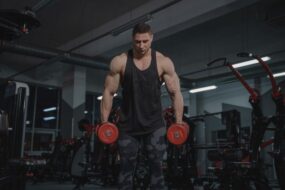
As a parent or coach, you may wonder when kids can start lifting weights. Weight training, also known as strength training, has many benefits for kids, including improved muscle strength, bone density, athletic performance, and boosting self-esteem and confidence. However, it’s essential to know when it’s safe for children to start lifting weights and how to do it properly to prevent injuries.
Table of Contents (click to expand)
What Is Weight Training?
Weight training is a form of exercise that involves lifting weights or using resistance to build strength and muscle mass. It can involve using body weight, free weights, weight machines, resistance bands, or other equipment. Weight training is essential for almost any sport and benefits young athletes looking to improve their performance.
Benefits of Weight Training for All Ages
Weight training is beneficial for people of all ages. It can help maintain good form, increase muscle mass, and improve heart health. A systematic review published in the Journal of Strength and Conditioning Research shows that weight training can help postmenopausal women maintain strong bones and healthy blood pressure.
Why Weight Training Is Particularly Important for Kids
Weight training is essential for children to build healthy bones, muscles, and joints. It can also help them maintain a healthy weight and reduce the risk of sports-related injuries. Additionally, weight training can improve body awareness and proper technique during physical activity, translating to better performance in organized sports.
The Risks of Weight Training for Kids
While weight training has many benefits, there are also safety concerns surrounding weightlifting for children. Injuries can occur if children lift too much weight or use improper techniques. Common injuries include strains, sprains, fractures, and growth plate injuries occur.
Safety Concerns When a Child Lifts Too Much Weight
Children who lift too much weight can put themselves at risk for injury. The American Academy of Pediatrics recommends that children avoid lifting heavy weights until they have reached physical maturity, usually around age 16. Younger children should stick to bodyweight exercises and resistance training with lighter weights.
The Importance of Proper Technique
Proper form is essential when it comes to weight training for kids. Children who use improper techniques can injure themselves or develop children. Children need to work with a personal trainer or experienced coach who can teach them how much weight to and the proper techniques.
Factors to Consider Before Starting Weight Training
Before starting a child on a strength training program, several factors must be considered. These factors include age, physical development, and medical conditions affecting weight training.
Age
The American Academy of Pediatrics recommends that children do not start lifting weights until after puberty and their bones have matured. Typically, this occurs between ages 12 and 16 for most children.
Physical Development
Children who engage in weight training should have good body awareness and coordination. They should also be able to follow directions and maintain good form throughout their workouts. It’s essential that they start with low weights and gradually increase over time.
Medical Conditions
Children with certain medical conditions may not be able to lift weights safely. These conditions include heart disease, high blood pressure, asthma, and diabetes. If your child has any of these conditions, it’s essential to consult their doctor before starting a weight training program.
Benefits of Weight Training for Kids
Weight training has many other benefits of strength training for kids beyond building muscle mass. Here are some of the major benefits of youth strength training:
Improved Muscle Strength
Weight training is an excellent way to improve muscle strength. It can help kids build stronger muscles, leading to better performance in organized sports and other physical activities.
Increased Bone Density
Weight training can also help improve bone density in young athletes. This is particularly important for girls, who are more likely to develop osteoporosis later in life.
Improved Athletic Performance
Weight training can help young athletes improve their performance in various sports. By losing weight, building muscle mass, and improving strength, kids can become faster, more agile, and more competitive.
Boosted Self-Esteem and Confidence
By achieving their fitness goals and building lean muscle mass, children can boost their self-esteem national strength and confidence. This can translate to better performance in all areas of their lives.
How to Get Started With Weight Training for Kids
If you’re interested in starting your child on a weight training program, there are several steps you can take to ensure their safety and success.
Work With a Personal Trainer or Experienced Coach
Working with a certified personal trainer or experienced coach can help ensure that your child uses proper techniques and exercises correctly following a safe and effective training program. These professionals can also help modify exercises for younger children or those just starting.
Choose the Right Equipment
Choosing the right equipment is important when it comes to weight training for kids. Younger children should stick to bodyweight exercises and resistance training with lighter weights. Older children can use free weights or weight machines but should start with light weights and gradually increase over time.
Proper Technique for Each Exercise
Proper technique is essential to prevent injuries and ensure that kids get the most out of their workouts. A personal trainer or experienced coach can teach your child the proper form for each exercise. Examples of exercises that can be done with push-ups child’s bones include push-ups, sit-ups, and bodyweight squats.
Goals and Progress Tracking
Setting goals and tracking progress can help keep kids motivated and engaged in their workouts. Encourage your child to set realistic goals and track their progress over time. Celebrate small victories and encourage them to keep pushing towards their fitness goals.
Weight Training Exercises for Kids
There are many exercises that kids can do to build strength and muscle mass. Here are some examples of exercises that can be done with younger children:
Bodyweight Exercises
Bodyweight exercises are an excellent way for younger children to build strength and coordination. Examples of bodyweight exercises include:
- Push-ups
- Sit-ups
- Plank
- Lunges
- Squats
Resistance Band Exercises
Resistance bands are a great option for younger children just starting with strength training. They provide resistance without putting too much strain on developing muscles. Examples of resistance band exercises include:
- Arm curls
- Leg extensions
- Standing shoulder press
- Lat pulldowns
Light Weightlifting Exercises
Older children can use free weights or weight machines to build muscle mass. However, it’s important to start with light weights and gradually increase over time. Examples of light weightlifting exercises include:
- Bench press
- Shoulder press
- Bicep curls
- Leg press
Safety Tips for Weight Training for Kids
Weight training for kids can be safe and effective if certain precautions are taken. Here are some safety tips to keep in mind:
Importance of Supervision
Children should always be supervised by a certified trainer or experienced adult when lifting weights. This is particularly important when children use free weights or heavier-weight machines.
Warm-Up and Cool-Down Techniques
Proper warm-up and cool-down techniques are essential to prevent injuries. Encourage your own child’s doctor to do a light aerobic exercise for five to 10 minutes before beginning their strength training program. After their workout, they should also do some stretching exercises to help prevent soreness and stiffness.
Proper Breathing Techniques
Proper breathing techniques can help prevent injuries and ensure kids get the most out of their workouts. Encourage your child to inhale deeply before beginning each repetition and exhale as they lift the weight.
The Importance of Rest and Recovery
Rest and recovery are essential to prevent injuries and ensure that kids get the most out of their workouts. Encourage your child’s muscles to take at least one day off per week and to get plenty of sleep and healthy food to aid in muscle growth.
Common Myths About Weight Training for Kids
There are many myths and misconceptions surrounding weight training for kids. Here are some commonly held beliefs about youth strength training and why they’re not true:
“Weight Lifting Will Stunt Growth”
This is a common myth that numerous studies have debunked. Weightlifting does not stunt growth, and no evidence suggests it does.
“Weight Lifting Is Dangerous for Kids”
While weight lifting can be dangerous if not done correctly, it’s perfectly safe for kids if they follow proper techniques and use appropriate weights.
“Girls Shouldn’t Lift Weights”
This is another common myth that numerous studies have debunked. Girls can benefit just as much from weight training as boys, and there is no reason why they shouldn’t lift weights.
Conclusion
Weight training can benefit kids, improving muscle strength, bone density, athletic performance and boosting self-esteem and confidence. However, it’s essential to know when it’s safe for children to start lifting weights and how to do it properly to prevent injuries. Following the tips outlined in this guide can help your child build healthy muscles and achieve their fitness goals safely and effectively.





































